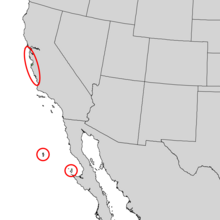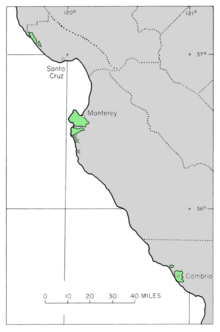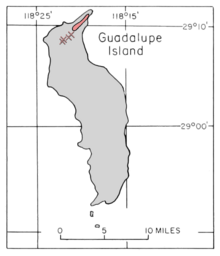Monterey pine
|
Pinus radiata Monterey pine |
|
|---|---|
 |
|
| Scientific classification | |
| Kingdom: | Plantae |
| Division: | Pinophyta |
| Class: | Pinopsida |
| Order: | Pinales |
| Family: | Pinaceae |
| Subfamily: | Pinoideae |
| Genus: | Pinus |
| Subgenus: | (Pinus) |
| Species: | P. radiata |
| Binomial name | |
|
Pinus radiata D.Don |
|
 |
|
| Natural range of Pinus radiata | |
 |
|
| … of Pinus radiata var. radiata | |
 |
|
| … of Pinus radiata var. binata | |
Pinus radiata, family Pinaceae, the Monterey pine,insignis pine or radiata pine, is a species of pine native to the Central Coast of California and Mexico (Guadalupe Island and Cedros island).
Pinus radiata is a versatile, fast-growing, medium-density softwood, suitable for a wide range of uses. Its silviculture is highly developed, and is built on a firm foundation of over a century of research, observation and practice. Radiata pine is often considered a model for growers of other plantation species. It is the most widely planted pine in the world, valued for rapid growth and desirable lumber and pulp qualities.
Although Pinus radiata is extensively cultivated as a plantation timber in many temperate parts of the world, it faces serious threats in its natural range.
It is native to three very limited areas located in Santa Cruz, Monterey Peninsula, and San Luis Obispo Counties. It is also found as the variety Pinus radiata var. binata or Guadalupe pine on Guadalupe Island, and a possibly separable P. radiata var./subsp. cedrosensis on Cedros Island, both in the Pacific Ocean off the west coast of the northern Baja California Peninsula in Mexico.
In Australia, New Zealand, and Spain it is the leading introduced tree and in Argentina, Chile, Uruguay, Kenya, and South Africa it is a major plantation species. It is also an introduced tree on the world's most remote inhabited island, Tristan da Cunha.
Pinus radiata is a coniferous evergreen tree growing to between 15–30 m (49–98 ft) in height in the wild, but up to 60 m (200 ft) in cultivation in optimum conditions, with upward pointing branches and a rounded top. The leaves ('needles') are bright green, in clusters of three (two in var. binata), slender, 8–15 cm (3.1–5.9 in) long and with a blunt tip. The cones are 7–17 cm (2.8–6.7 in) long, brown, ovoid (egg-shaped), and usually set asymmetrically on a branch, attached at an oblique angle. The bark is fissured and dark grey to brown.
...
Wikipedia

